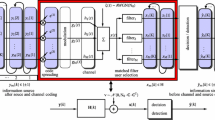Abstract
Data detection in the presence of interference is one of the main challenges in multicarrier code division multiple access (MC-CDMA) communication systems. In this paper, a new detection technique for downlink MC-CDMA systems is proposed. This technique uses complex-valued multilayer neural networks at the receiver side. With the new definition for desired responses (±(1+J) instead of ±1, where \( J = \sqrt {{ - 1}} \)), the convergence rate is increased (in the training process) regarding to saturation of imaginary output and the performance is increased because of increasing Euclidean distance of output neuron inputs in two states of desired outputs (with factor of \( \sqrt {2} \)). The performance of the proposed method is improved further by considering two various saturation coefficients (in the activation function of output layer) in the training and test processes. Since the last performance improving lead to low convergence rate, this effect is compensated by correcting the coefficient of training rate in the output layer. Simulation results confirm the high convergence rate, low computational complexity, and also good performance of the proposed method in wide range of SNRs.












Similar content being viewed by others
References
Nekouei DE (2005) Detection in MC-CDMA communication system using methods based on EM algorithm, Master of Science Thesis, Tarbiat Modarres University, Iran
Hara S, Prasad R (1997) Overview of multicarrier CDMA. IEEE Communication Magazine 35:126–133
Yee N, Linnartz JP, Fettweis G (1993) Multicarrier CDMA in indoor wireless radio network. Process IEEE PIRMC’93, Yokohama, Japan, pp 109–113
Prasad R, Lee RV (2000) OFDM Wireless Multimedia Communications. Artech House, Norwood
Vedru S (1998) Multiuser detection. Cambridge University Press, New York
Mitra U, Poor HV (1995) Adapt receiver algorithms for near-far resistance CDMA. IEEE Transaction on Communication 43:1713–1724
Xie SZ, Short RT, Rushfurth CK (1990) A family of suboptimum detectors for coherent multi-user communications. IEEE J Select Areas Comm 8:683–690
Lupas R, Vedru S (1990) Near-far resistance of multiuser detectors in asynchronous channels. IEEE Tran On Comm 38:496–508
Lupas R, Vedru S (1989) Linear multiuser detectors for asynchronous code-division multiple access channels. IEEE Transaction on Information Technology 35:123–136
Senevirathna HMSB, Yamashita K (2005) Multi-user detector for MC-CDMA using nonorthogonal wavelet neural networks. Signal Processing and Information Technology, pp 301–305
Carlier F, Nouvel F (2003) Neural network for multi-user detection in MC-CDMA systems. Vehicular Technology Conference 4:2399–2403
Soujeri E, Bilgekul H (2002) Hopfield multiuser detection of asynchronous MC-CDMA signals in multipath fading channels. Communication Letters 6:147–149
Ko K, Choi S, Kang C, Hong D (2001) RBF multiuser detector with channel estimation capability in a synchronous MC-CDMA system. Transaction on Neural Network 12:1536–1539
Haykin S (1999) Neural networks: a comprehensive foundation. Prentice Hall, Upper Saddle River
Nitta T (2003) Solving the XOR problem and the detection of symmetry using a single complex-valued neuron. Neural Networks 16:1101–1105
Kao JW-H, Berber SM, Kecman V (2010) Blind multiuser detector for chaos-based CDMA using support vector machine. IEEE Transactions on Neural Networks 21(8):1221–1231
Taspinar N, Cicek M (2011) Neural network based receiver for multiuser detection in MC-CDMA systems. Wireless Personal Communications. doi:10.1007/s11277-011-0462-9
Isik Y, Taspinar N (2005) Parallel interference cancellation based on neural network in CDMA systems. IEICE Trans Commun 88(2):800–806
Isik Y, Taspinar N (2007) Multiuser detection with neural network and PIC in CDMA systems for AWGN and Rayleigh fading asynchronous channels. Wirel Pers Commun 43:1185–1194
Shayesteh MG, Amindavar H (2003) Performance analysis of neural network detectors in DS/CDMA systems. AEU Int J Electron Commun 57(3):220–236
Isik Y, Taspinar N (2006) The multi-user detection in code division multiple access with adaptive neuro-fuzzy inference system. J Inf Sci Eng 22:1529–1542
Chuah TC, Sharif BS, Hinton OR (2002) Robust CDMA multi-user detection using a neural-network approach. IEEE Trans on Neural Networks 13(6):1532–1539
Wang J, Yang H, Hu X, Wang X (2011) An adaline neural network-based multi-user detector improved by particle swarm optimization in CDMA Systems. Wirel Pers Commun 59:191–203
Nitta T, Furuya T (1991) A complex back-propagation learning. Tran on Inf Process Society of Japan 32(10):1319–1329
Nitta T (2002) On the inherent property of the decision boundary in complex-valued neural network. Neuro Computing 50:291–303
Lathi BP (1998) Modern digital and analog communication systems, 3rd edn. Oxford University Press, Oxford
Nitta T (1997) An extension of the back-propagation algorithm to complex numbers. Neural Networks 10(8):1391–1415
Author information
Authors and Affiliations
Corresponding author
Rights and permissions
About this article
Cite this article
Mahdipour Hossein-Abad, H., Nezamabadi-pour, H., Abbasi-Moghadam, D. et al. Joint detection, channel estimation, and interference cancellation in downlink MC-CDMA communication systems using complex-valued multilayer neural networks. Ann. Telecommun. 68, 467–476 (2013). https://doi.org/10.1007/s12243-012-0332-9
Received:
Accepted:
Published:
Issue Date:
DOI: https://doi.org/10.1007/s12243-012-0332-9




